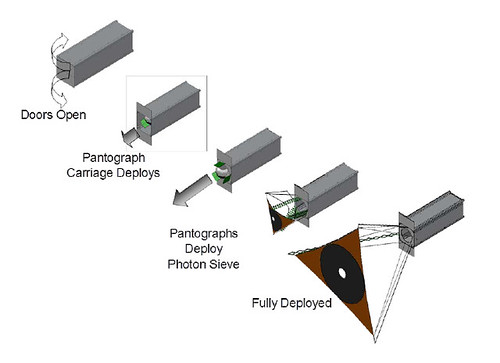“Cellophane Telescope” by Seymour Sun
Wednesday, October 3rd, 2012The payload deployment test shown above moves the FalconSAT-7 mission forward, which is scheduled for 2015. Why is this “cubesat” important? It uses diffraction instead of refraction or reflection and it is becoming a real alternate to a large space-based observatory in studying the Sun’s chromosphere — especially in the H-alpha wavelengths.

The cubesat is being developed by the U.S. Air Force Academy and NASA’s Goddard Space Flight Center, among others, including the NRO, DARPA, AFOSR, AFIT, MMA Design and AFRL.
A photon sieve is a novel optical element consisting of a flat opaque sheet with millions of tiny holes. Light passing through these holes is focused in a similar manner to a lens or a mirror. Photon sieves have several key advantages over those more conventional optics:
- Focusing can be achieved from a flat, thin sheet that can be unfurled from a very compact, lightweight package
- Surface quality tolerances are orders of magnitude more relaxed
- The fabrication costs are much lower
The trade-offs include:
- Lower efficiency / loss of light
- Narrow bandwidth giving what are essentially grayscale images
The photon sieve will have the following design parameters:
- 200mm diameter, 400mm focal length, 656.3nm wavelength
- 2.5 billion holes ranging in size from 2-277 microns
- 50% fill factor, 30% focusing efficiency
The telescope has a relatively simple design due to space constraints and has:
- 4 µrad resolution which equates to 600 km at Sun surface
- ~0.1 degree field of view (about a 1/5th of the Sun’s disk)

Clockwise from top left: A 4-inch photon sieve lit by laser light. The focal spot produced. A magnified image of the central 25mm. An image of a resolution chart produced by the sieve. An interferogram of the wavefront that indicates perfect focusing capability.